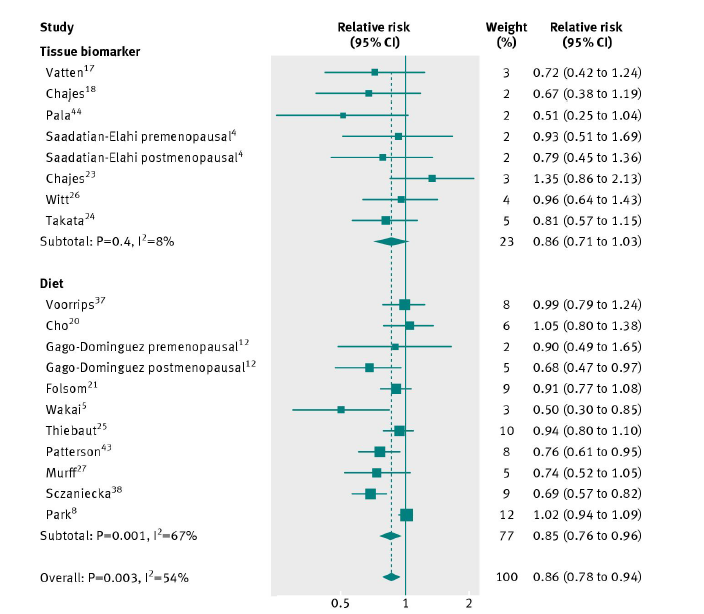The paper from Zheng et al., a meta-analysis of 21 studies on omega-3s and risk of breast cancer, concludes that higher consumption of omega-3s corresponds with lower risk of breast cancer.
The chart below is a forest plot of relative risk of breast cancer when comparing highest category of omega-3, from either blood measurements or diet reports, vs. the lowest category of omega-3. If risk was the same in the highest vs. lowest category of omega-3, the relative risk was 1.0.

How do you read this chart?
The purpose of a forest plot is to help you see the forest for the trees. They are used often in a meta-analysis, such as this paper. The idea is to compare two things for one outcome, in this case, highest vs. lowest omega 3 for risk of breast cancer).
The vertical line, labeled as 1, is the risk of getting breast cancer associated with the lowest group of omega 3. You want to be to the left, or less than 1. In this plot, most points are to the left, showing a lower risk of breast cancer with higher levels or consumption of omega-3s.
Each point also has an associated bar with it – this represents the 95% confidence interval used in statistics. In reality it means the point could be anywhere along that line.
Finally the big diamond at the bottom is the aggregate risk for all of the studies. In this paper they did an aggregate for just blood levels, for consumption, and for both. Overall, those with the highest intake or blood levels of omega 3 had a 14% lower risk for breast cancer compared to those with the lowest.
What should you do with this information?
If you already take omega-3 supplements or eat a diet high in omega-3s, perhaps you do nothing different. This chart was derived from studies that reported on either intake or tissue biomarkers. At GrassrootsHealth we know that effectiveness of dietary omega 3 intake or supplementation varies greatly from person to person. That is why we believe you need to test, not guess and for Omega-3s Index, and keep your level at 8% or higher for preventive health. Studies in the past frequently reported only on the “groups” participants were in, how much of a supplement or drug was given to each person, not how it was received in the body. In the future we will see more studies that report on blood levels, as this important point about nutrient research becomes more widely understood.
What is an n-3 PUFA?
An n-3 polyunsaturated fatty acid, also called an omega-3 fatty acid or even just omega-3, is essential for good health. They exist in the blood stream and feed cells, much like glucose. Fatty acids that are not made in the body are called essential fatty acids, and must be obtained from food. Within the omega-3 category, essential fatty acids are docosahexaenoic acid (DHA), eicosapentaenoic acid (EPA), and alpha-linolenic acid (ALA).
References
Intake of fish and marine n-3 polyunsaturated fatty acids and risk of breast cancer: meta-analysis of data from 21 independent prospective cohort studies
Zheng JS et al.
BMJ
June 2013
Read Paper

